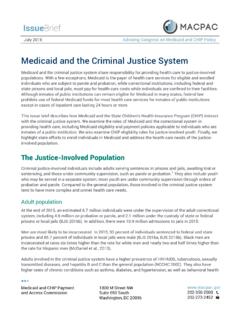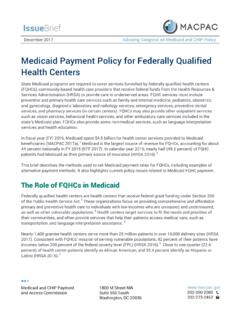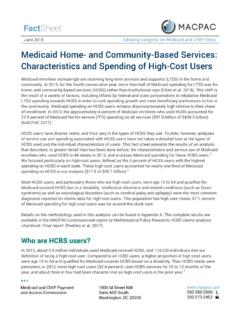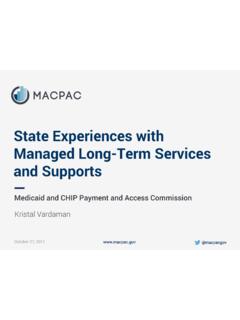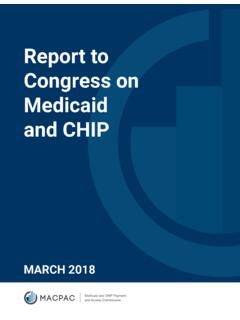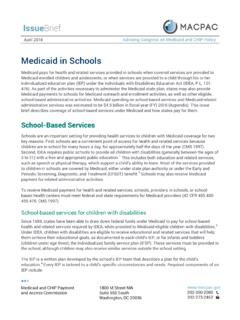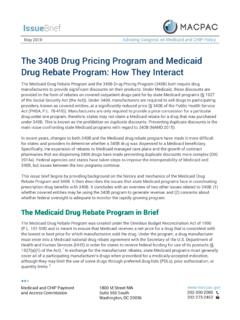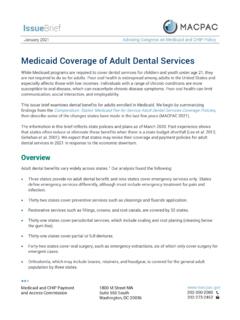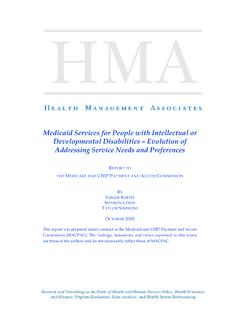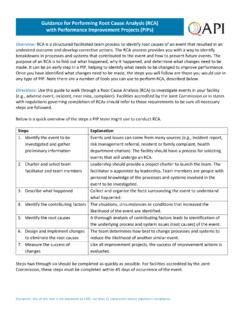Transcription of Medicaid Payment Policy for Out-of-State Hospital Services
1 January 2020 Advising Congress on Medicaid and CHIP Policy Medicaid Payment Policy for Out-of -State Hospital Services Although most Medicaid enrollees obtain medical Services within their state of residence, some enrollees seek care Out-of-State under certain circumstances. Current Medicaid regulations describe four situations in which states must provide Out-of-State coverage: a medical emergency; the beneficiary s health would be endangered if required to travel to the state of residence; Services or resources are more readily available in another state; or, it is general practice for recipients in a particular locality to use medical resources in another state (42 CFR ). States have broad flexibility to determine Payment rates for Services provided out of state and the processes that providers must follow to enroll as an Out-of-State Medicaid provider.
2 Specifically, many states pay Out-of-State providers at lower rates than in-state providers and require Out-of-State providers to undergo provider screening and enrollment even if the provider is already enrolled in medicare or Medicaid in another state. Some providers have raised concerns that these policies may reduce providers willingness to serve Out-of-State Medicaid beneficiaries and may result in delays in care while provider enrollment is processed (Manetto et al. 2018). Hospital Services comprise the largest category of Medicaid spending and the only one for which we have reliable data about Out-of-State service use. This brief reviews the use of Out-of-State Hospital Services in Medicaid and the various ways that states pay Out-of-State hospitals. Overall, we find that children who are eligible for Medicaid on the basis of a disability are more likely to have Out-of-State Hospital stays than other types of Medicaid enrollees and that children s hospitals serve a higher share of patients from Out-of-State than other types of hospitals.
3 The use of Out-of-State care may increase in the future as a result of the Advancing Care for Exceptional Kids Act (ACE Kids Act, 116-16), which includes provisions intended to facilitate Out-of-State care for children with disabilities. The ACE Kids Act also requires the Centers for medicare & Medicaid Services (CMS) to issue guidance by October 2020 on best practices for ensuring that children with complex medical conditions receive prompt care out of state when medically necessary. More information about state Payment policies for Hospital Services is available in MACPAC s compendia of state Payment policies for inpatient and outpatient Services (MACPAC 2018, 2016). 2 Use of Out-of-State Hospital Services In fiscal year (FY) 2013, about 2 percent of Medicaid Hospital stays occurred out of the patient s state of residence (Table 1).
4 About half of these stays occurred at hospitals in neighboring states that were located in the same Hospital -referral region (HRR) where the patient lived. An HRR is a geographical designation that describes regional health care markets tertiary medical In 2017, about one-third of HRRs overlapped multiple states. TABLE 1. Out-of-State Medicaid Inpatient Hospital Stays by Eligibility Group, FY 2013 Eligibility group Total number of stays (millions) Share of stays out of state Share of Out-of-State stays in a different HRR than enrollee Total Non-disabled children Non-disabled adults Disabled children Disabled adults Notes: FY is fiscal year. HRR is Hospital -referral region. Analysis excludes individuals enrolled in both medicare and Medicaid and those age 65 and older. Ten states are excluded because of lack of complete managed care encounter data (Alaska, Kansas, Maryland, Missouri, Nebraska, Nevada, Oregon, Rhode Island, Washington, and West Virginia).
5 For more information on our method for classifying Out-of-State Hospital stays, see Appendix B. Source: MACPAC, 2020, analysis of FY 2013 Medicaid Statistical Information System data. Children who qualify for Medicaid on the basis of a disability have a higher share of Out-of-State inpatient Hospital stays than other eligibility groups. These children are also more likely to access care outside of the HRR where they reside. Use of Out-of-State hospitals varies widely by state, based in part on the extent to which residents live near other states. For example, Hawaii, which does not border any states, had the lowest share of Medicaid Hospital stays out of state ( percent), while Vermont had the highest ( percent). As discussed further below, Vermont reduces barriers to Out-of-State care by designating certain border hospitals as Vermont Medicaid providers and paying these hospitals the same rates as in-state hospitals.
6 Complete information on the distribution of Out-of-State Hospital stays by state is provided in Appendix A. Hospital characteristics In FY 2013, less than half of hospitals ( percent) provided care to Medicaid enrollees who resided outside the state where the Hospital was located (Table 2). However, percent of children s hospitals served Out-of-State patients, a higher share than other types of hospitals. Psychiatric, long-term care, and children s hospitals were more likely to serve Out-of-State patients from outside their HRR than from within their HRR, while the majority of Out-of-State stays for other Hospital types came from within the same HRR as the Hospital . 3 TABLE 2. Medicaid Stays by Hospital Type and Out-of-State Status, FY 2013 Hospital type Number of hospitals in analysis Total Medicaid stays Out-of-State stays as a share of total Medicaid stays Average number of states represented by Out-of-State Medicaid stays Total Share of hospitals with Out-of-State Medicaid stays Share from Out-of-State patients Share from Out-of-State patients in a different HRR Total 4,616 6,024,307 Short-term acute care Hospital 2,966 5,600,348 Critical access Hospital 998 91,488 Psychiatric Hospital 172 50,049 Long-term care hospitals 238 7,483 Rehabilitation Hospital 161 6,654 Children's hospitals 81 268,285 Notes: FY is fiscal year.
7 HRR is Hospital -referral region. Average number of states Out-of-State Medicaid patients are from excludes hospitals without Out-of-State visits and does not include the state the Hospital is located in. Analysis excludes individuals enrolled in both medicare and Medicaid and those age 65 and older. Ten states are excluded because of lack of complete managed care encounter data (Alaska, Kansas, Maryland, Missouri, Nebraska, Nevada, Oregon, Rhode Island, Washington, and West Virginia). Analysis also excludes stays that could not be linked to medicare cost report data (n=512,407). For more information on our method for classifying Out-of-State Hospital stays, see Appendix B. Source: MACPAC, 2020, analysis of FY 2013 Medicaid Statistical Information System data and medicare cost report data. States also vary in the extent to which hospitals receive Medicaid payments from multiple states.
8 On average, hospitals with Out-of-State Medicaid patients received Medicaid payments from about three different states in FY 2013, but children s hospitals received Medicaid payments from more than six states, on average. Some children s hospitals received Medicaid payments from more than 25 states in FY 2013. Provider enrollment Requirements In order to receive Payment for Medicaid Services , providers must enroll with the program in the patient s state of residence and meet federal screening requirements. These requirements are similar to those under medicare , and states are not required to conduct additional screening for limited risk providers, such as hospitals, that have been previously screened by medicare or another state (CMS 2018). However, states are not required to use screening data from medicare or other states and they are allowed to conduct additional screening beyond the minimum federal requirements.
9 As of June 2019, 24 states and the 4 District of Columbia relied on screenings conducted by medicare to facilitate their Medicaid provider enrollment (GAO 2019). Current state requirements for screening and enrolling Out-of-State providers vary widely (GAO 2019 and HMSA 2018). Some states, such as California, do not require separate screening for Out-of-State providers and have established an express enrollment process for Out-of-State providers (DHCS 2020). Other states require Out-of-State providers to follow the same process as in-state providers regardless of whether they are enrolled in Medicaid in another state. In addition, state requirements for screening and enrolling providers sometimes differ for Services provided under fee-for-service (FFS) and managed care delivery systems. Payment Methods for Out-of-State Hospital Services States have considerable flexibility in how they set Hospital rates, including those for hospitals in other states.
10 States that establish different rates generally pay Out-of-State hospitals less than in-state providers. As of November 2018, 18 states and the District of Columbia paid Out-of-State hospitals using the in-state rate for inpatient Hospital Services in their fee-for-service (FFS) Medicaid programs, and the remaining 32 states paid a different Out-of-State rate (MACPAC 2018). As of July 2016, 14 states paid Out-of-State hospitals the in-state rate for outpatient Services provided under FFS, and the remaining 36 states and the District of Columbia paid a different Out-of-State rate (MACPAC 2016). We do not have information on how managed care plans pay hospitals. Most states pay for inpatient Hospital Services using diagnosis-related groups (DRGs) and many of these use the same underlying methodology for in-state and Out-of-State providers even if the Payment rate is different.
